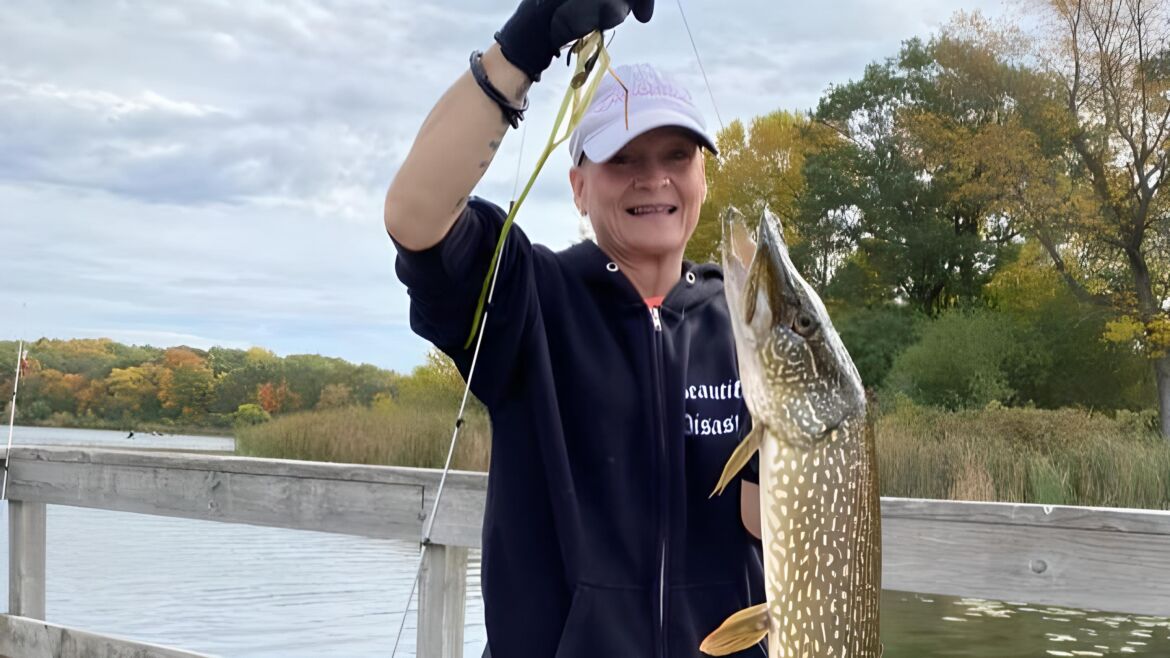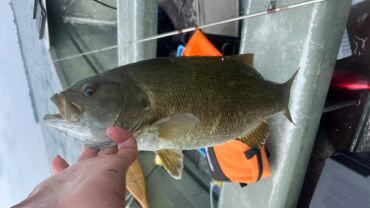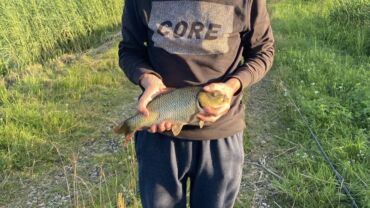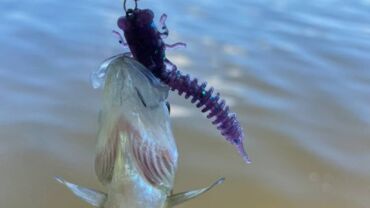Wisconsin is easily one of the greatest freshwater angling paradises in the United States, with thousands of streams, rivers, and lakes all teaming with fish such as Bass, Trout, Salmon, Pike, and Walleye.
With over 15,000 lakes and easy access to Lake Michigan and Lake Superior, Wisconsin is home to non-stop freshwater fishing action. The hardest decision you’ll have to make is choosing where you plan on fishing in Wisconsin and the Wisconsin fishing season that suits you best.
One of the most commonly asked questions we get asked is when is the best season to go fishing in Wisconsin? In the following article, we’ll cover everything you need to know about the start and end of the Wisconsin fishing seasons, the Wisconsin fishing opener, and the best WI game fish.
In the following guide to the Wisconsin fishing seasons, we’ll cover:
If you love Bass fishing, you’ll love this article, The Ultimate Guide: Discovering the Best State for Bass Fishing Bliss, to learn about the best states to catch monster Bass!
When it comes to finding secret fishing spots in Wisconsin and local Walleye or Bass hot spots, you’ll need a little help. If you want to be landing fish during the WI fishing opener, you’ll need the premium Fishing App, Fishbox App. Thanks to the Fishbox App, you’ll know the perfect time to go fishing in Wisconsin and when you’re better off staying home and cleaning out your tackle box.
Get your personalized fishing map
Answer a quick quiz and get your own personalized fishing map
Expert Opinion on Wisconsin Fishing Seasons
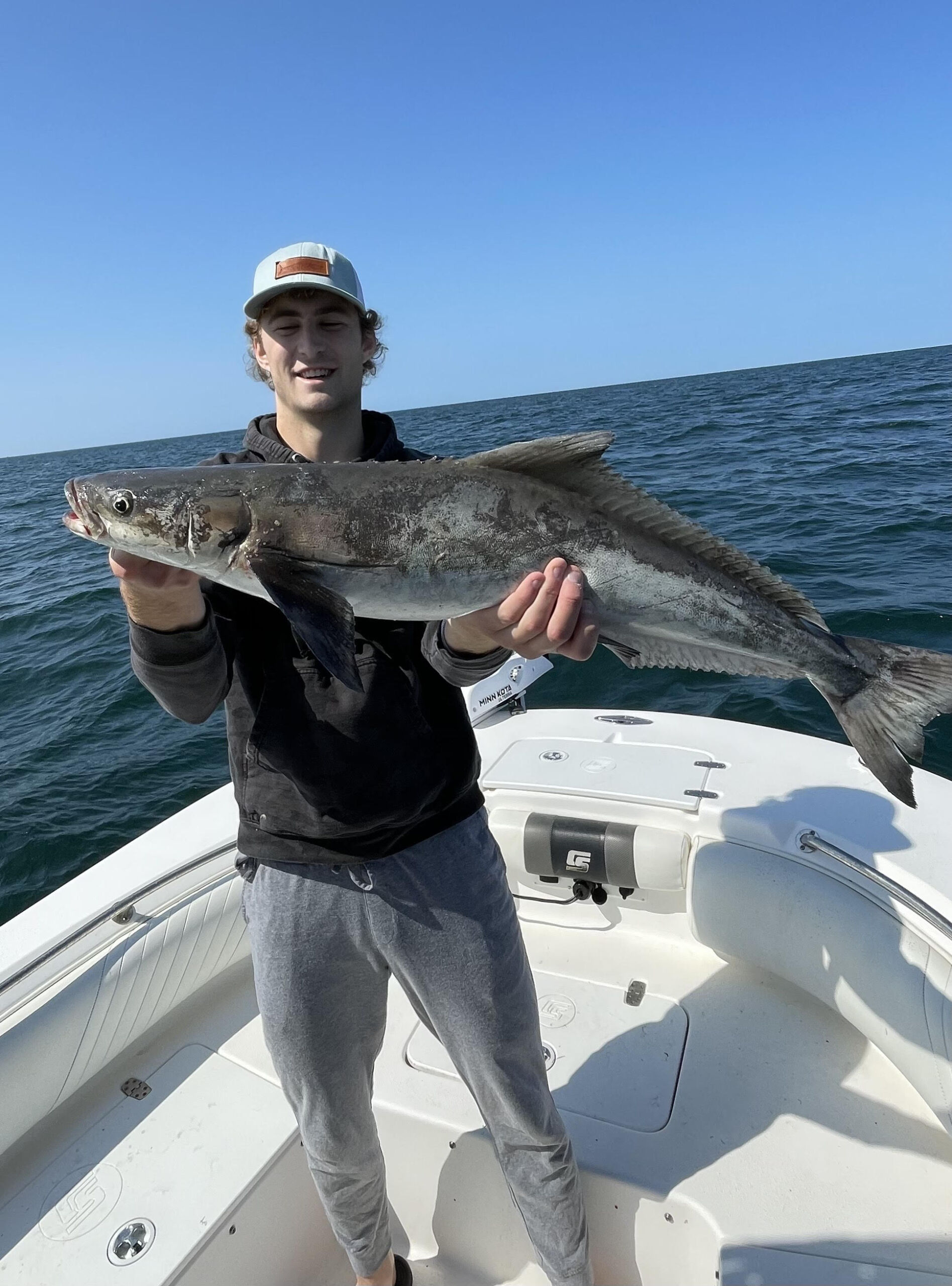
Pierce Latta
16 years fishing experience
“While Wisconsin doesn’t have a saltwater fishery, its freshwater fishery certainly makes up for it and much more. From Lake Superior to the tiny little streams that are scattered all across the state, you can be sure that Wisconsin will always have something to offer anglers. Wisconsin offers a fairly strong fishery all year long, but April to November is where the action really heats up across the entire spectrum of species found in the state. Various species of Trout and Salmon fill rivers and streams across the state and the elusive musky and pike begin to start chewing as well. As you can hopefully see from the article, regulations and fishing seasons are a big way that Wisconsin can consistently stay a great fishery for anglers of future generations. This being said, please pay attention to local and federal regulations as they ensure the safety of fish stocks for years to come. Also please note that this is not just necessarily a size limitation but can also be season openings regarding things like catch and release practices. All in all, just don’t be stupid and respect the environment that God has blessed us with. As I was reading over this article, I realized for the first time in my life that Sturgeon can be caught in Wisconsin. These are a huge bucket list fish for me and will one day make the trip to catch one of these giants. This being said, if you are blessed to be a native of Wisconsin or have the opportunity to travel there, take advantage of the unique fishery that is at your fingertips and don’t take it for granted. Realize that you can catch some species that others can’t and make the most of these opportunities. If you take a look at the middle of the article, there is a section on the different types of fishing you can do based on the months of the year. Pay careful attention to this part and really use it to your advantage if you happen to be fishing in Wisconsin. It can give a great overview of some of the different options you have available based on the level of bite at that specific point in the year. But like I’ve mentioned many times before, data and statistics can only go so far, so do your own research and get outside to test these theories for yourself. Additionally, further down in the article, it mentions some top fishing spots in Wisconsin including places like Big St Germain Lake, Black Earth Creek and more. I’ll say it again, use these spots as a place to start if needed, but in order to become the best angler you can be you need to find your own secret spots. Every great angler I’ve ever met has told me that their most successful days of fishing have come from times when they just went out and winged it. They just kept changing tactics, baits, and locations until something stuck—and when it stuck—it stuck. So, keep this in mind when you’re fishing for a new body of water whether it be Wisconsin or somewhere else. Tight lines!”
Visit his Instagram profile.
Subscribe to his YouTube channel.
Understanding Wisconsin Fishing Seasons (Fishing Calendar)
If you take a look at the Wisconsin fishing season calendar below, you’ll be able to see that the best Wisconsin fishing seasons are Spring and Fall. However, there’s also good fishing to be had almost year-round in Wisconsin, depending on which fish species you’re targeting.
| WI Fish Species | Jan | Feb | Mar | Apr | May | Jun | Jul | Aug | Sep | Oct | Nov | Dec |
| Bass | Poor | Poor | Fair | Good | Great | Great | Great | Great | Good | Fair | Poor | Poor |
| Brown Trout | Fair | Fair | Fair | Good | Good | Good | Great | Great | Great | Good | Fair | Fair |
| Muskellunge | Fair | Fair | Fair | Good | Good | Good | Great | Great | Great | Great | Good | Fair |
| Yellow Perch | Good | Good | Great | Good | Good | Good | Good | Good | Good | Good | Good | Good |
| Northern Pike | Fair | Fair | Fair | Good | Great | Great | Good | Fair | Fair | Fair | Fair | Fair |
| Rainbow Trout (Steelhead) | Good | Good | Good | Good | Fair | Fair | Fair | Fair | Good | Great | Great | Good |
| Chinook Salmon | Poor | Poor | Poor | Great | Great | Great | Good | Fair | Poor | Poor | Poor | Poor |
| Coho Salmon | Poor | Poor | Poor | Great | Great | Great | Fair | Fair | Poor | Poor | Poor | Poor |
| Walleye | Fair | Fair | Fair | Good | Great | Great | Good | Fair | Fair | Fair | Fair | Fair |
The Wisconsin Fishing Opener
The Wisconsin Fishing Season Opener for 2024-2025 kicks off on the first Saturday in May, so if you’re planning a fishing trip or being out on the water, make sure that you mark that date in your calendar. However, different bodies of water and fish species have different regulations.
Before you hit the water or plan a trip, make sure that you check out the Wisconsin DNR webpage. The Wisconsin DNR will give you a detailed breakdown of what fish species you can catch and where and when you can catch them.
Specifics of Wisconsin Fishing Seasons
Below, we’ll do a quick breakdown of each month throughout the Wisconsin game fish season, including what your best target species will be for each month.
- January – The first Saturday in January marks the beginning of the Wisconsin inland Trout fishing season, so be sure to mark this important date. Class 1, 2, and 3 streams are now open, so if you’re a fly-fishing enthusiast, get your fly-fishing gear ready! Ice fishing is still an option if you’re looking to catch a big Walleye.
- February – February means the end of ice fishing unless you’re targeting one of the heavily iced lakes or rivers. Don’t forget to try the Mississippi River for Pike and Walleye. Another cool thing to try is the Sturgeon Spearing on Lake Winnebago.
- March – Once the last of the ice melts away from Lake Superior, the trolling action for large Salmon and Trout will start to heat up. Try your luck near the Bayfield and Washburn landings. If you’re looking for a nice table fish, Perch is a great option and responds well to bright lures and live baits.
- April – The spring peak has arrived in April in Wisconsin, and there’s some hot Walleye action to be had at DePere Dam. You’ll need to put in some long hours and arrive early if you want to secure yourself a good spot in this trophy Walleye location!
- May – Lake Winnebago and Green Bay are hot spots for Walleye, and Bass fishing is starting to heat up. The first Saturday of May is the Northern Largemouth Bass opener, but Smallmouth Bass remain catch and release until the end of June.
- June – Panfish and Bass are at their peak in June, while the Trout and Salmon action on Lake Michigan is probably the best fishing you’ll experience all year, thanks to the warmer water levels. June fishing on Lake Michigan is your best chance of landing a large Chinook Salmon or Coho Salmon along with both Lake and Rainbow Trout.
- July – Let’s talk about Muskellunge, better known as Muskies, the state fish of Wisconsin. Muskies like clear, shallow water, and you’ll need to be patient if you want to catch one. Topwater lures and bucktails are a great way to catch these finicky fish.
- August – Muskies are still biting strong in August, but the Bass and Panfish make a great alternative. Because of the evening heat in August, try to plan for evening fishing sessions throughout the summer months if you’re chasing Bass.
- September – Ask many local anglers in Wisconsin, and they’ll tell you that September is possibly the best month to go fishing throughout the Badger State. This is in part because the fishing is still good but also because there are a lot fewer anglers on the water. Steelhead and Trout in Lake Michigan are still great but don’t forget the Northern Pike on the Mississippi River or Largemouth Bass and Bluegill.
- October – Most of the inland fishing action is done in October, but the Walleye action is still good. Try targeting deep water in the lakes of the Madison Chains, such as Lake Waubesa and Lake Monona.
- November – The last day of November is the end of the Musky season, but the Walleye are beginning to go to school together, which means you can get some tremendous late-evening action on Lake Wisconsin.
- December – Start looking for the thick ice if you love ice fishing! Devil’s Lake is the only Southern Lake where you can target Brown Trout and Rainbow Trout through the ice.
Before you hit the water or plan a trip, make sure that you check out the Wisconsin DNR webpage. The Wisconsin DNR will give you a detailed breakdown of what fish species you can catch and where and when you can catch them.
Get your personalized fishing map
Answer a quick quiz and get your own personalized fishing map
Wisconsin Game Fish
Thanks to Wisconsin’s abundant freshwater ecosystem, there’s a huge variety of freshwater gamefish to be caught. In the following section, we’ll cover some of the most popular game fish in Wisconsin and why people enjoy catching them.
- Walleye – Walleye is a prized catch for many anglers thanks to its white, flaky, and delicious flesh. It’s commonly targeted by both recreational and sports anglers. The Walleye fishing season is open from May 4th – March 2nd, 2025. Spoons, jigs, swimbaits, and crankbaits are your best chance of landing a big Walleye.
- Trout – Trout species available in Wisconsin include Rainbow, Brook, and Brown Trout. Popular amongst fly fishers, the Early Inland Trout (catch and release) season starts on January 6th (5 a.m.) – May 3rd, and the General Inland Trout opens on May 4th (5 a.m.) – Oct. 15th.
- Perch – Both Yellow Perch and White Perch are popular target species in Wisconsin thanks to their delicate taste. Yellow Perch is a popular eating fish and is available in General Inland Waters year-round. However, the Boundary and Outlying Waters season starts the first Saturday in May to March 1, but the open season for yellow perch is May 20 to March 15
- Bass – Largemouth and Smallmouth Bass are considered to be superior game fish by many Wisconsin anglers. You’ll find Largemouth Bass in warmer water with plenty of vegetation to hide in, while the Smallmouth Bass prefer deep, cooler water.
- Sturgeon – Sturgeon Spearing is a long-honored tradition in Wisconsin. You can learn more about Sturgeon Spearing on Lake Winnebago here. The Lake Sturgeon season starts Feb. 10 – Feb. 25 for spearing and Sept. 7 – Sept. 30 for hook and line fishing.
- Muskellunge – Muskies is the official state fish of Wisconsin. The aggressive strike of the Musky makes it highly sought after. You can check out the complete regulations for Muskies here.
Read also: Unveiling the Secrets of Freshwater Fishing: A Guide to the Best Lures
Regulations and Guidelines
The opening day for Wisconsin is traditionally the first Saturday in May every year. However, season dates will vary for each species depending on where you’re fishing. For a detailed breakdown of the Wisconsin regulations and guidelines, you can check out The Guide To Hook And Line Fishing Season Dates, 2024-2025. This will tell you exactly what fish you can catch, where you can catch them, and most importantly, when you can catch them.
The Wisconsin 2024-2025 Fishing Season
- Early Inland Trout (catch and release) starts on January 6th (5 a.m.) and ends on May 3rd.
- General Inland Trout starts on May 4th (5 a.m.) and runs until Oct. 15th.
- General Inland Fishing starts on May 4th and runs until March 2nd, 2025.
- Largemouth Bass Northern Zone Harvest starts May 4th and runs until March 2nd, 2025.
- Smallmouth Bass Northern Zone Harvest starts on June 15th and runs until March 2nd, 2025.
- Large And Smallmouth Bass Southern Zone Harvest starts on May 4th and runs until March 2nd, 2025.
- Large And Smallmouth Bass Catch And Release is available all other times of the year.
- Musky Northern Zone Harvest starts on May 25th and runs until Dec. 31st.
- Musky Southern Zone Harvest starts on May 4th and runs until Dec. 31st.
- Northern Pike starts on May 4th and runs until March 2nd, 2025.
- Walleye begins on May 4th and runs until March 2nd, 2025.
- Lake Sturgeon runs from Feb. 10th to Feb. 25th for spearing. (spearing) and Sept. 7th through Sept. 30th for hook and line fishing.
- Free Fishing Weekends are available on Jan. 20-21, 2024, and June 1-2, 2024.
Preparing for the Wisconsin Fishing Opener
The Wisconsin Fishing Season Opener for the 2024-2025 fishing season starts on the first Saturday in May, so if you’re planning a fishing trip or being out on the water, make sure that you mark that date in your calendar.
If you’re planning on traveling to Wisconsin or within Wisconsin for a specific fishing location or species, be sure to book your accommodation in advance and don’t leave it to the last minute. Fishing locations and accommodation are in high demand for the fishing opener, so don’t leave it until the last minute.
It’s essential to note that different bodies of water and fish species have different regulations. Before you plan a trip or wet a line, make sure that you check out the Wisconsin DNR webpage. The Wisconsin DNR will give you a detailed breakdown of what fish species you can catch and where and when you can catch them.
Before the season opener, ensure all your fishing equipment, including rods, reels, tackle, and line, are in excellent working order. Replace old lines and hooks, and oil your reels. If you have a spare fishing rod, it’s a good idea to bring it, and if you don’t, grab one. The last thing you want is to be left on the water without a rod and reel during the best fishing of the year.
Notable Fishing Spots in Wisconsin
Below, we’ll list the Top 5 fishing spots in Wisconsin and why they’re so popular with both local anglers and visiting anglers.
- Big St Germain Lake – While Big St Germain Lake isn’t the biggest lake in Wisconsin, it is home to some fantastic Northern Pike. It’s not just Pike, though. The lake also contains Panfish, Large and Smallmouth Bass, Trout, and Walleye. There are various public access points to launch and retrieve a boat, but due to water clarity, it’s not the best sight fishing option in the state.
- Black Earth Creek – This world-renowned stream is famous for its Class 1 Trout and regularly attracts fly fishing enthusiasts from across the country and worldwide. Check the fishing regulations before planning your trip, as the waters are closely managed for both conversational and environmental reasons to protect the fishery.
- Jack Lake – If you plan on fishing in Wisconsin with the whole family, then Jack Lake is the place to do it. It’s only a small lake, approximately 85 acres, but it’s packed full of Panfish, Trout, Walleye, Largemouth Bass, Bluegill, and Yellow Perch.
- Kickapoo River – If you enjoy eating trout, then you’ll be happy to know that you can keep all the trout you catch in Kickapoo River. This river is regularly stocked with hatchery trout, which means that you can keep them and eat them. While you can fish from the shore, the best fishing opportunities require a small boat.
- Puckaway Lake – Puckaway Lake offers arguably some of the best shallow-water fishing in Wisconsin. There are various public access locations, and the fish species present in the lake include Catfish, Northern Pike, Musky, Panfish, Walleye, and Largemouth Bass.
Seasonal Fishing Tips
While spring and summer are relatively similar to fish in regarding what type of gear you use, ice fishing over the cold winter months in Wisconsin will require some special knowledge, equipment, and tips if you want to have a successful winter fishing trip in Wisconsin.
What can you expect to catch through the ice in winter? Some of the fish species you can expect to catch during the frozen winter months are Bluegill, Yellow Perch, Whitefish, Walleye, and Northern Pike.
When does the ice fishing season start in Wisconsin? Depending on the weather, ice typically starts to form around late December. Most lakes will stay frozen until March or April, but you’ll need to remain vigilant and check ice thickness.
Where are the best places to go ice fishing? Below, we’ll cover the most popular ice-fishing locations in Wisconsin.
- Green Bay – Green Bay is an incredible place for ice fishing in Wisconsin, and the target species here is Walleye. Some of the hotspots in Green Bay include Sturgeon Bay, Fox River, and Oconto, just to name a few. If you’re new to ice fishing, your best bet is to hire a local guide who will get you set up on the ice with everything you need. Along with the Walleye, there are also some big Whitefish and Perch.
- Lake Winnebago – Be prepared to catch a mixed bag of Perch, Walleye, White Bass, and Sturgeon at Lake Winnebago. There’s a lot of ice to cover on the lake, so there’s plenty of room to fish.
- Dairyland Reservoir – Located on the Flambeau River in the northwest part of Wisconsin, this prime ice-fishing spot attracts anglers from across the country. It’s packed with Panfish, Bass, Pike, and Walleye. Dairyland offers both catch and release and also the opportunity to bring home a trophy-sized fish.
- Black Oak Lake – This body of clearwater is home to Walleye, Northern Pike, Bass, Lake Trout, and loads of Panfish. Even though it’s only a small lake compared to many others in Wisconsin, because of its small size and location, you can start ice fishing here in early to mid-December.
- Boom Lake – Known as the ‘Ice fishing capital of the world,’ Boom Lake is located in the center of Rhinelander and even offers ice fishing tournaments. Muskies, Northern Pike, Panfish, Walleye, Bass, and many more species. There are a variety of lodges available around the area, so after a cold night of ice fishing, you can relax in beautiful accommodation with friends.
Get your personalized fishing map
Answer a quick quiz and get your own personalized fishing map
What equipment do you need to go ice fishing in Wisconsin? Below, we’ve prepared a list of the different tools and equipment you’ll need for ice fishing. However, if you’ve never been before or aren’t going with an experienced ice fisherman, then hiring a guide is a great place to start for your first Wisconsin fishing trip.
Ice fishing tools and equipment:
- Auger – This is a drilling tool that you use to drill a hole through the ice.
- Chisel – Also known as a spud, you can use this tool to chip or expand holes in the ice.
- Portable Seat – While an upside-down bucket works as a seat, you’ll be sitting down for a while, so a portable seat is a great option when ice fishing.
- Skimmer – You’ll need to keep that ice hole clean, and a skimmer will help you remove chunks of ice from the hole and keep it clear.
- Sled – Getting your fishing gear from the truck or car to your ice fishing location takes a lot of work, and a sled will make it a whole lot easier. Some people utilize a snowmobile, but you need to check the thickness of the ice first.
- Tip–Up – This is a device that lets you know that you had a bite by raising a flag.
- Ice Shanties – To stay out of the weather, an ice shanty is the perfect way to do it. There’s a variety of different sizes and styles depending on your budget.
Read also: Fishing in Cold Weather: Tips and Techniques for Winter Anglers
Wisconsin Fishing Seasons: Your Comprehensive Guide – Conclusion
If you’re looking for a mix of excellent Spring and Summer fishing, with some great Winter ice fishing, Wisconsin is a great state to do it. Check out the calendar we created above to choose the best month to visit Wisconsin for your fishing trip, depending on what species you’re targeting.
Before you hit the water in Wisconsin, be sure to check with the local fishing regulations to ensure that you have the correct license and that your target fish species is in season. While some waters offer year-round fishing, others have closed seasons to allow fish the best opportunity during spawning.
If you only have the time or budget for one fishing trip this year, Wisconsin is a great state to visit, and it’s packed full of exciting fishing opportunities for anglers of all ages.
Taking advantage of the Fishbox App will allow you to track weather conditions accurately, and it works by combining predictive fish behavior with weather, lunar, and tidal conditions to deliver optimal fishing opportunities in WI.
The app for fishing was developed in collaboration with accurate weather data and expert fish behavioral analysis. These advanced forecasts will significantly increase your catch rate while reducing your time on the water. Take your fishing to the next level thanks to the expert advice from the Fishbox App team.
